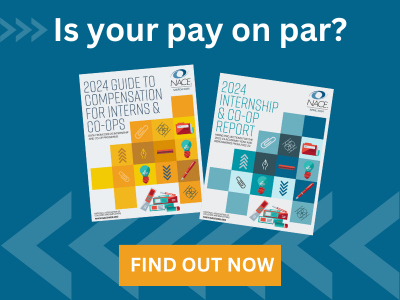NACE Journal / Spring 2023
By way of providing some context, I’m writing this article on March 14, 2023—three years to the day of my hastily arranged flight home from Chicago, midway through a series of planned campus focus groups. The topic I was researching? “Delivering an Authentic Candidate Experience.” As we navigated through the pandemic, what has been a central theme of my work since 2016—recruiting authenticity and its impact—has taken on even greater significance, and that work-in-progress project assumed the role of an unintentional benchmark. Spring 2020 became my baseline for much of what has unfolded since then.
This piece summarizes what my research surfaced throughout these past three seasons, where the findings have led me, and how employers can level up their candidate experience. Because with as much as students’ expectations for authenticity have remained constant—if not strengthened since 2020—the reality of their job search has introduced some challenges that are impacting how they assess employers and their opportunities.
To frame the discussion about students valuing employer authenticity, consider Figure 1 from my current spring 2023 research project. With an agreement rating of close to 95%, the data make a strong case for deep-diving what students’ expectations are for an authentic candidate experience—what it is, what it isn’t, and why.
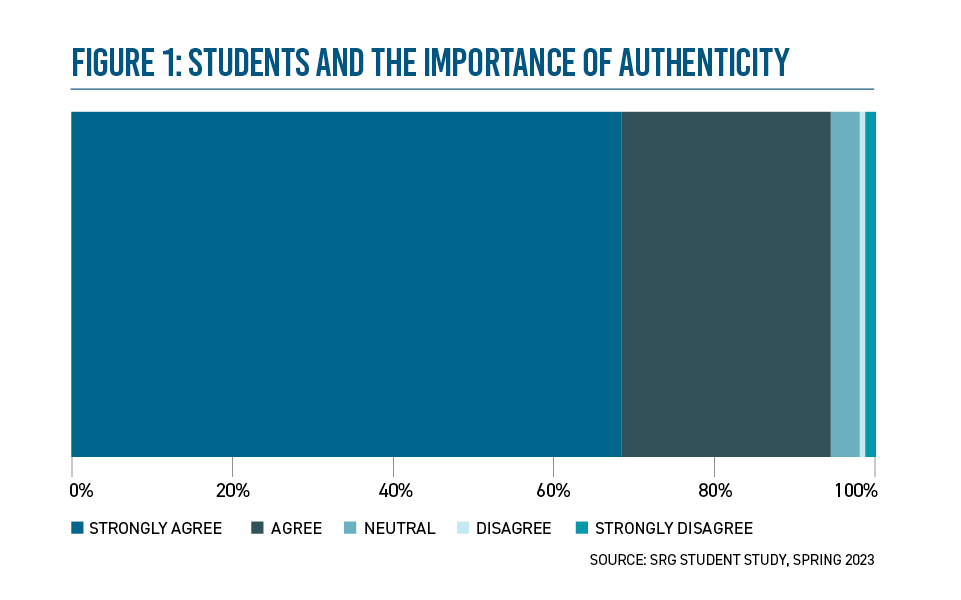
Is “Relationships vs. Transactions” the New “High Touch vs. High Tech?”
I’ve been researching and reporting on the long-standing debate in early talent recruiting circles about “high touch versus high tech” since the previous millennium(!), but the COVID-induced rapid transition to virtual candidate engagement caused me to rethink and reframe the question along the lines of “relationships versus transactions.” With personal, high-touch interaction not a viable option for upwards of two years at some universities, recruiters were faced with all sorts of unfamiliar challenges, key among them how to differentiate their organization and its opportunities from an ever-expanding array of virtual competitors.
One of the interesting findings to surface in my research in those early “what works? what doesn’t?” days was that attempts to replace traditional campus recruiting events with their virtual counterparts, e.g. digital career fairs, Zoom information sessions, did not replicate the authenticity of in-person recruiting. Fully 60% of students who participated in my “Virtual Candidate Experience” study in April 2021 disagreed with the statement “Virtual events are as authentic as face-to-face;” only 21% agreed.
What was emerging, however, was a decided ramping up of the impact of transactions on students’ assessment of recruiting satisfiers and dissatisfiers. Candidate experience elements such as response timeliness and transparency have always been important, but as many employers debated how to present innovative and engaging virtual events, how students were sorting out desirable employers actually focused on the “blocking and tackling” aspects of their interaction.
Consider Figure 2, which features data from spring 2021 that illustrates the comparative ratings of how students assessed the execution differentiation of the “most” and “least” impressive and effective candidate experience, first in relation to “fun” virtual events, and then in regards to “responded within the promised timeframe.” Despite the time and effort many employers invested in creating ways to appeal to students using virtual platforms and tools, it was employers’ ability to meet timeline expectations that were more closely aligned with providing candidates with an impressive and effective experience. (See Figure 2.)
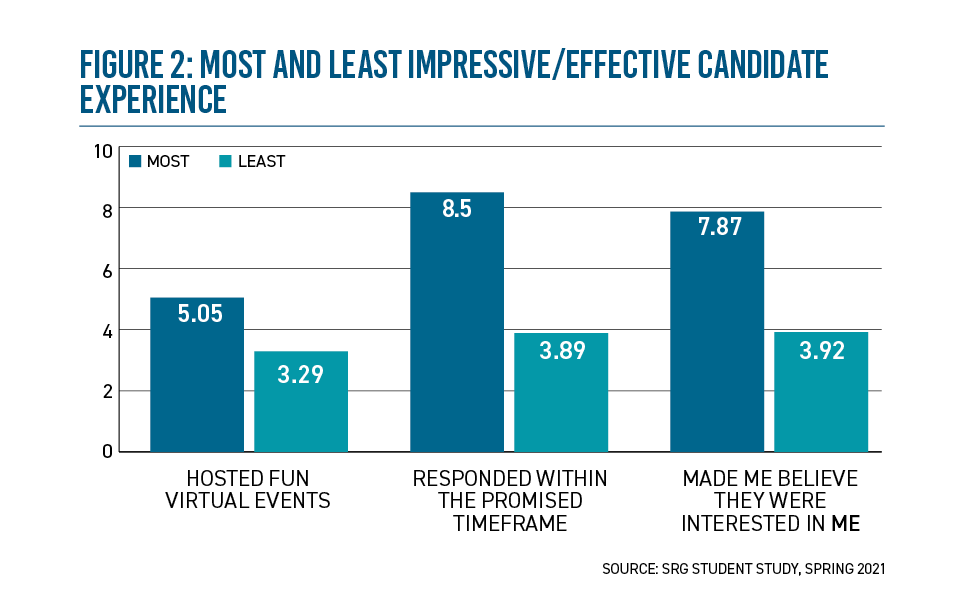
Authentic Communications
One of the most significant developments that first gained traction in the early days of virtual recruiting—and for good and sufficient reasons—was employers’ widespread use of templated email campaigns to reach out to students. This served the intended purpose of spreading a much wider “agnostic” net to students who attended universities nationwide, and was anecdotally reported to expand the volume of applicants, especially among the diverse populations employers target.
For all the benefits these campaigns delivered, however, an unintended consequence was—and continues to be—what I have dubbed the “email tsunami.” Students have been overwhelmed with campaign messaging, to the degree that fully half of surveyed students over the past two years have agreed that they’ve blocked some job-related email. (See Figure 3.)
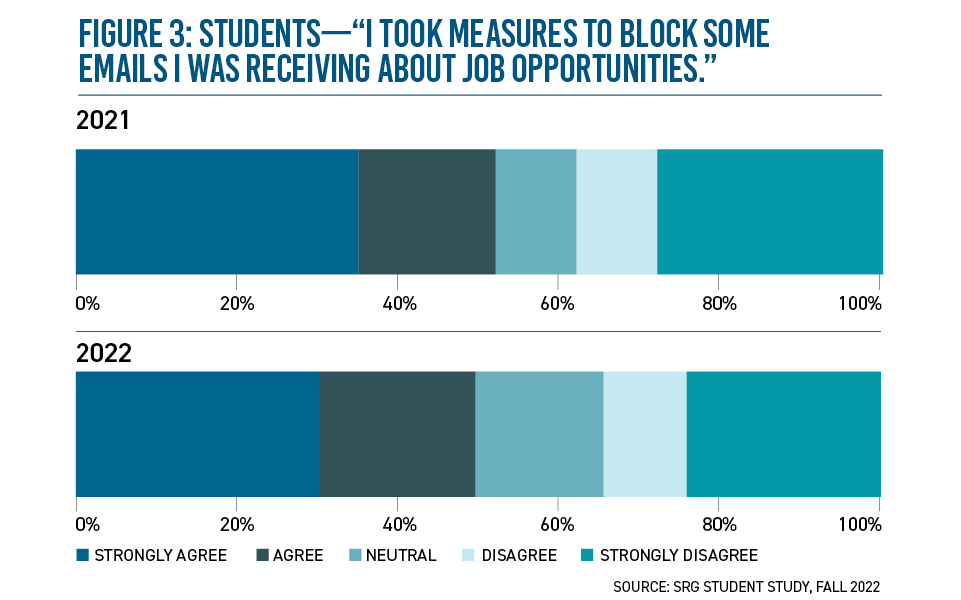
It’s not just the volume of emails students receive that is at issue: It is the templated aspect as well. Not only do students object to the very impersonal nature of messaging that has obviously been sent far and wide, but reports of seemingly indiscriminate distribution abound. My survey and focus group participants continue to provide countless anecdotes about epic mismatches, e.g., an architectural engineer solicited for a package delivery position, as well as examples of relentless messaging, such as receiving the same email five times in one day from the same employer. Annoying? Absolutely. Authentic? Not a chance.
So, what do students consider to be authentic outreach? With minor exception,* every research project I’ve conducted over the past three years has returned the same relative value ranking. (See Figure 4.)
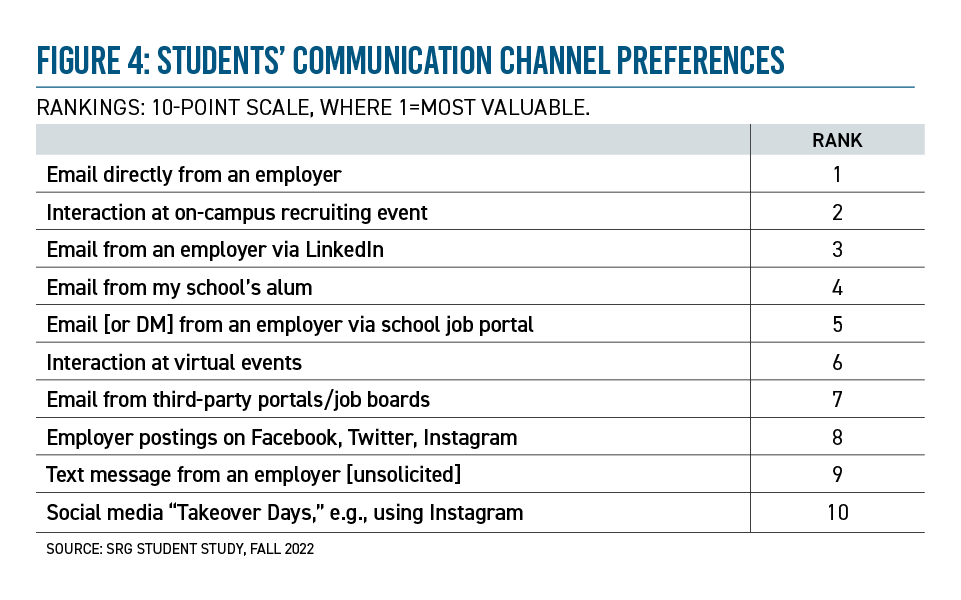
Of equal significance and importance: Not only has how students force rank the value of communications channels remained constant throughout the pandemic, but it mirrors their pre-COVID preferences as well.
Trusted Sources of Recruiting Information
Since 2019, my research with students has included a 35-factor roster of recruiting sources of information along with a 10-point scale that addresses level of agreement that the person, platform, event, or tool is trusted in terms of authenticity. What has remained constant over that five-year time horizon, with all its twists and turns, is that people-based sources of information have consistently remained in the top 10, while those that have comprised the bottom 10 have included a host of digital platforms, social media, and on-demand recorded video interviewing.
Herein lies one of the challenges of transitioning to digital recruiting: Employers justifiably point to the substantial time and budget savings that result from significantly reduced travel, a hallmark of traditional campus recruiting. However, those savings incur a considerable opportunity cost—authenticity.
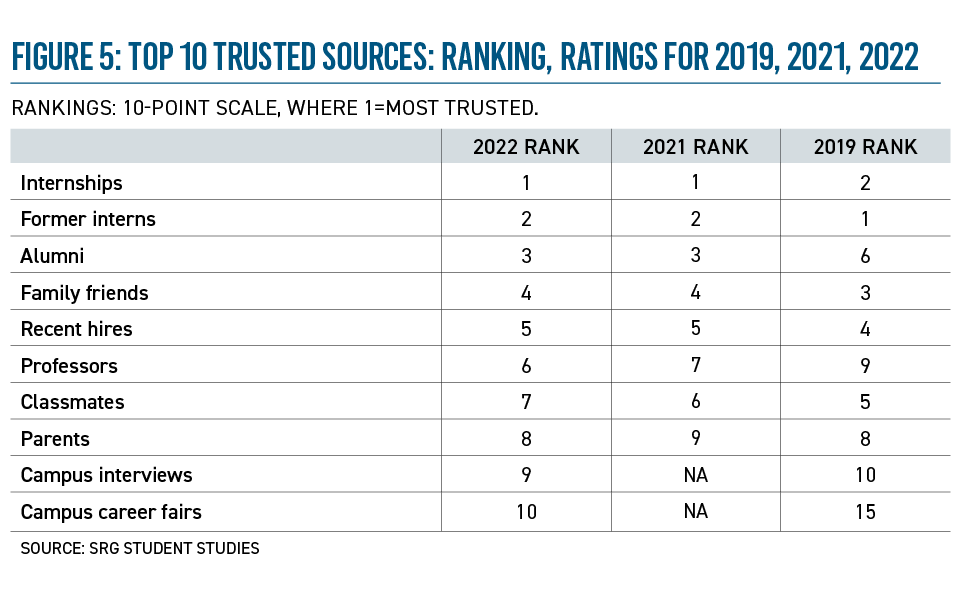
Recruiting Events
What became clear as we maneuvered through the 2021-22 recruiting cycle was that virtual platforms and tools can indeed play a role in employers’ early talent outreach and engagement; they offer convenience, especially when the purpose of an event is to disseminate information and/or to present content, rather than to interact. This was apparent in my research findings as early as fall 2020, and my conclusion has remained consistent since that time.
One interesting data trend that has caught my eye, however, is that students’ assessment of the virtual events they have attended have rated significantly lower as “impressive and effective” than their in-person pre-pandemic equivalents. I have described their ratings as being in the “meh” range. In addition, responses to related text questions specific to asking about “WOW!” recruiting events and experiences have invariably surfaced comments about the candidate experience itself.
In terms of the hybrid recruiting experience, which has become the norm, Figure 6, from fall 2022, illustrates two key points. First, yes, students consider building relationships a more likely outcome when engagement is face to face, but that still presents challenges, especially if the encounters are brief. However, being able to gauge culture was rated significantly higher when engagement was face to face rather than virtual.
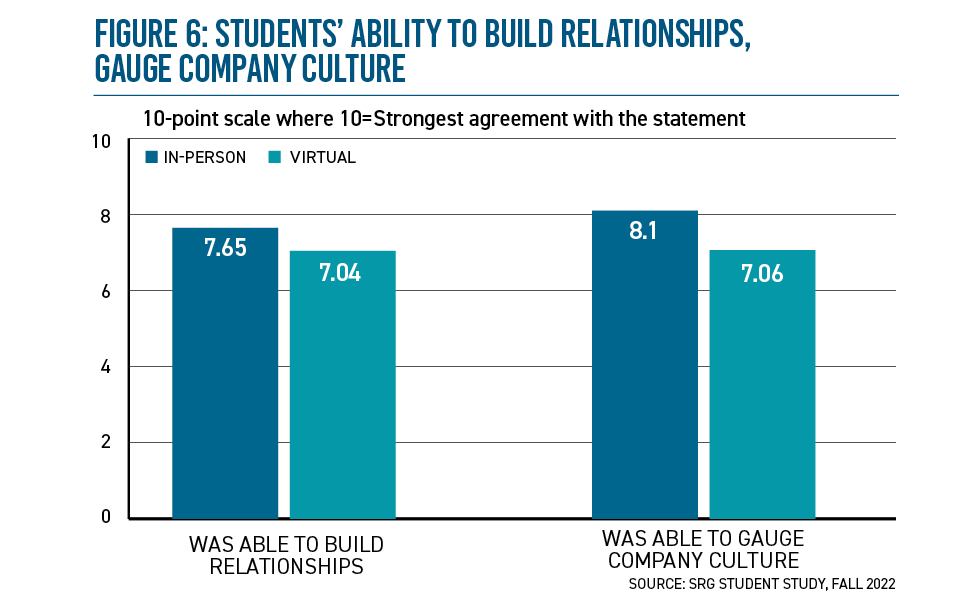
To that point, what has repeatedly surfaced in my ongoing attempts to find that elusive “secret sauce” for employers to unlock the ability to differentiate themselves from their recruiting competitors, the bottom line is this: Rarely has a student offered a comment that answered the question “what employer is doing it right?” with a response that maps to anything but how they are treated as a candidate.
As self-evident as it sounds, the candidate experience must appear genuine. It is not convincing for an organization to drape a banner below its career fair signage that proclaims “We’re Authentic!,” as a student recounted in a 2019 focus group.
Impact of Authenticity on Offer Acceptance and Reneges
Earlier in this article, I discussed the correlation between how students measured a transactional aspect of their candidate experience (“responded within the promised timeframe”) and their assessment that an employer “made it seem as though they were interested in ME.” The latter is a metric I’ve used extensively in campus research projects and client work because I have long heard from students that it is their candidate experience—transactions and relationships alike—that helps them differentiate among employers. With all that has changed over the past three years, I looked at data from 2016 and compared it to fall 2022. (See Figure 7.) The falloff in those agreeing with the “made it seem as though they were interested in me” statement is dramatic, dropping from more than 90% in 2016 to barely 50% most recently.
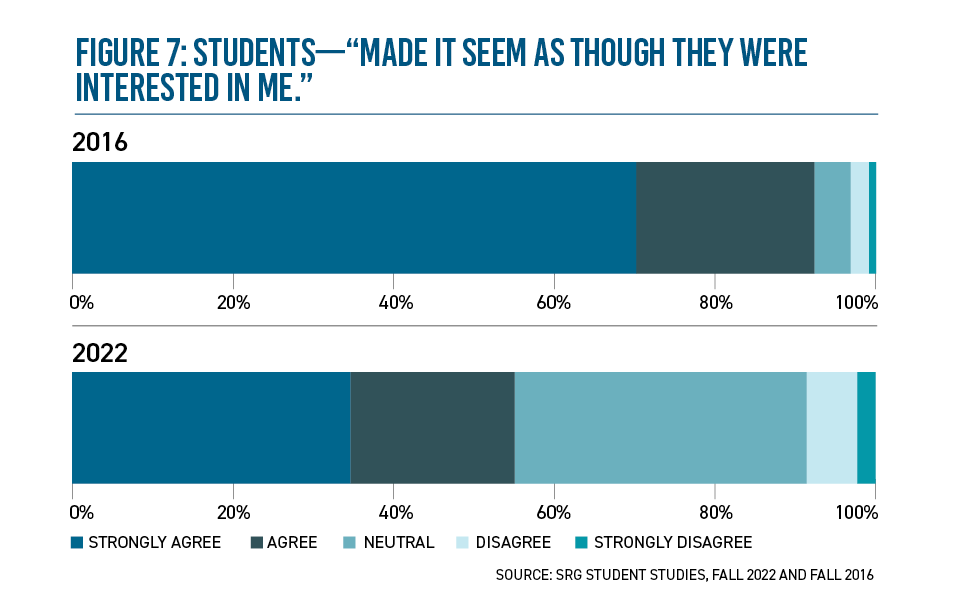
There may well be factors in addition to the transition to digital recruiting at play here, but Figure 8, comparing data from these same two studies, clearly illustrates a major shift in student attitudes over the past few years, which has likely contributed to a drop in acceptance rates. [Editor’s note: NACE’s 2022 Recruiting Benchmarks Report shows the current acceptance rate is 69.3%, down from 73.6% in the previous year’s report.]
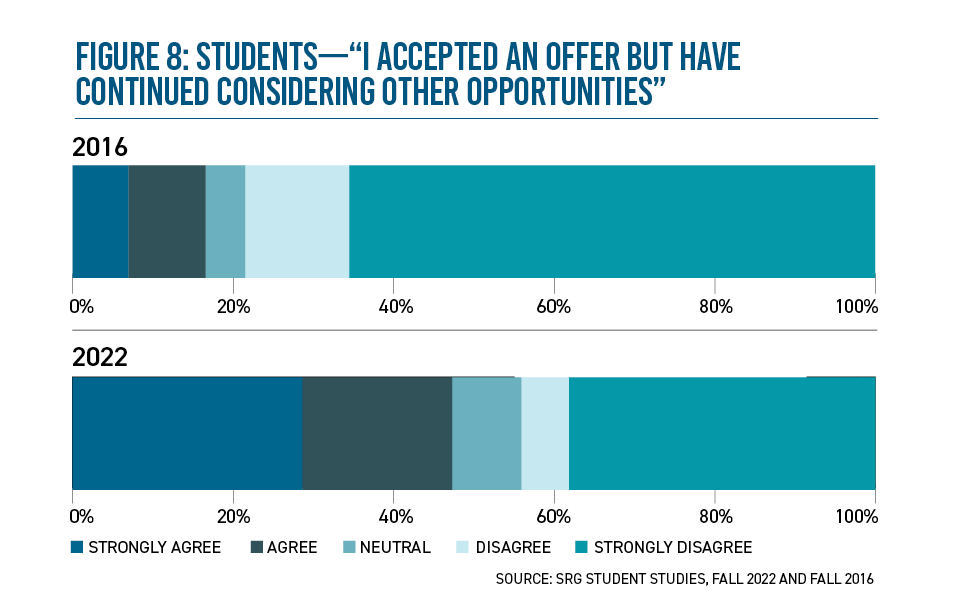
For one more data point to add to considerations about why students are more likely to decline or renege on an offer they’ve accepted, take a look at Figure 9—it indicates that if students don’t feel connected to the employer, they have no qualms about declining an offer, or even reneging on one.
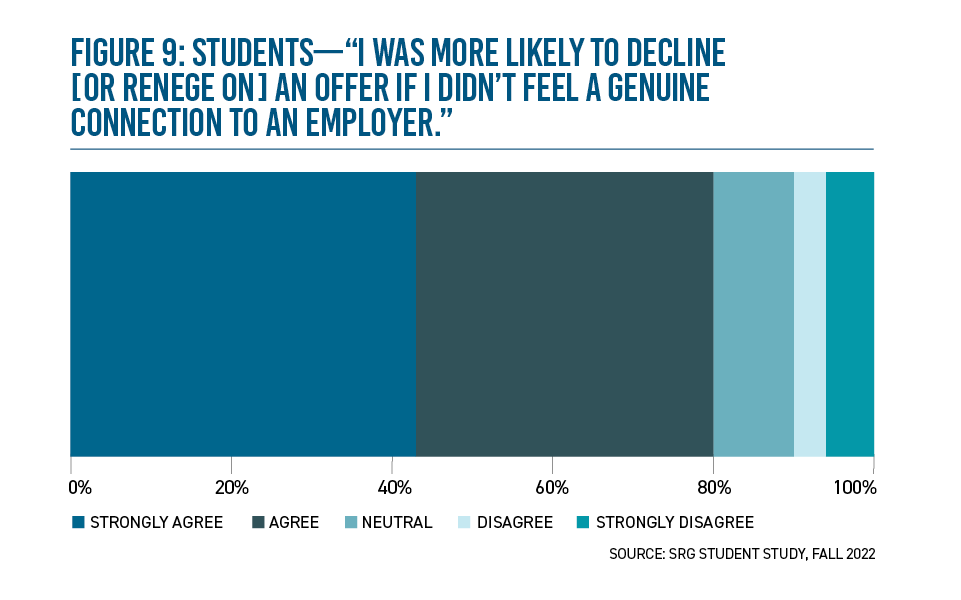
How to Offer an Authentic Candidate Experience—and Why It Matters
With these unfiltered data to provide context and perspective, here is where my research throughout the pandemic has led me, and what I’m proposing as a model for employers to use as a framework to focus their integrative candidate experience design and execution.
The operational model suggests a way to think about how students interact and engage with employers during their job search.
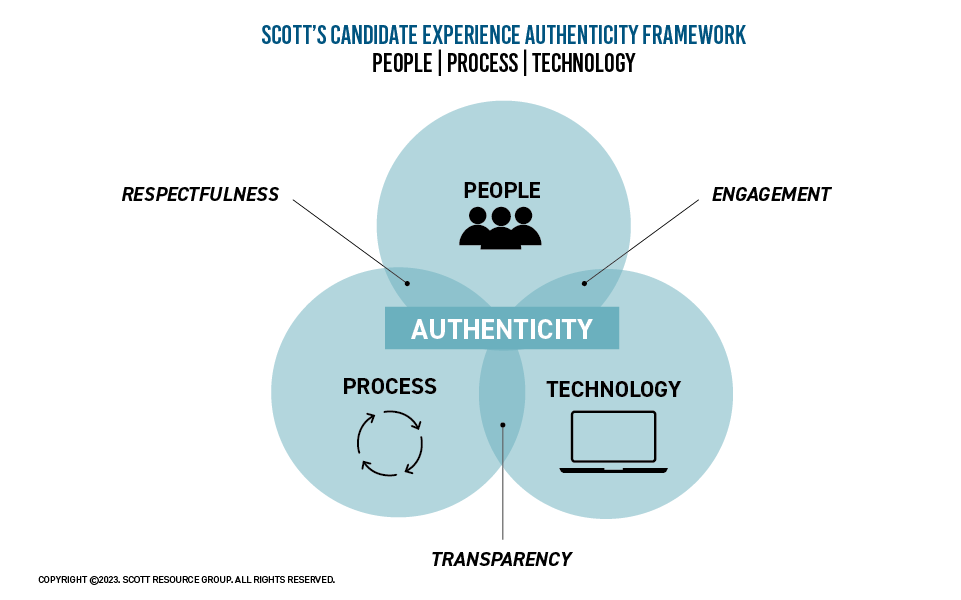
The three equally weighted intersecting circles—people, process, and technology—overlap and intersect. Each of the model’s circles comprises comprehensive levels of strategy and tactics, but, for better and for worse, all too often it is the actual execution piece that influences the candidate experience.
Consider the recent example a survey participant who reported stopping by the career fair booth of a major employer, and rather than engaging with a representative (the people circle), found a sheet of paper with a QR code to submit an application (technology). Can a QR code serve a purpose? Sure. Unfortunately, whether by design or not, this human-replacement process felt to him like a lack of respectfulness and put a quick end to his interest in the company. Moreover, from this, he not only inferred that the company wasn’t interested in him but, by extension, that the company wasn’t genuinely interested in other students at his school.
The model led me create the hierarchy below, which expands the concept to highlight both the transactional and relationships components of the candidate experience. What has become obvious over the past three years is that successful early talent recruiting today is built on both “high touch” and “high tech.”
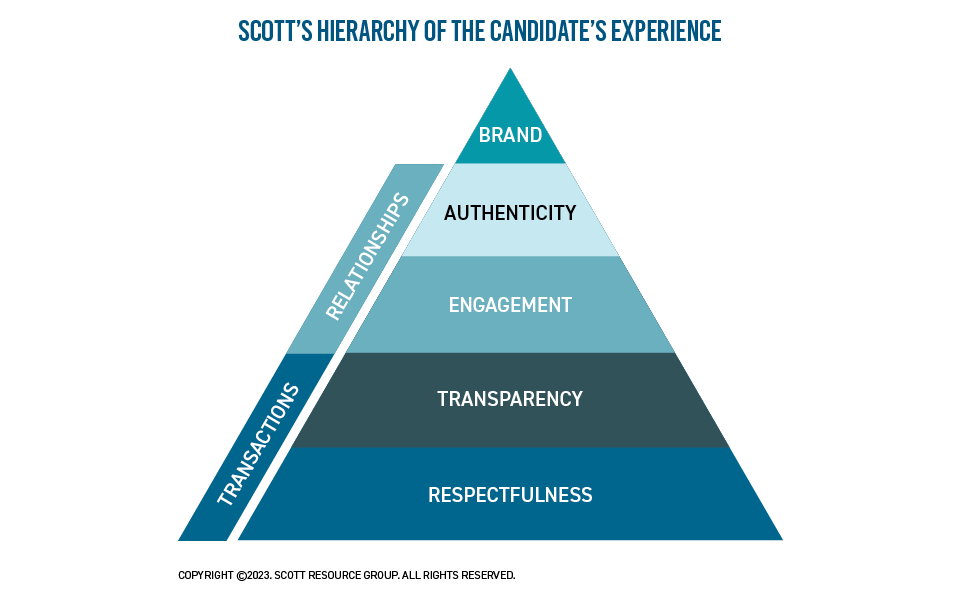
Expanding on the people, process, technology framework, the hierarchy pyramid displays the comprehensive elements of the candidate experience. Based on extensive, longitudinal quantitative and qualitative research, I have identified eight granular process touchpoints that align with students’ assessment of their recruiting journey. What is important to note is that the transactional factors aligned with respectfulness and transparency have historically been rated by students as most impactful; response timeliness was “a thing” long before the current scourge of ghosting. Simultaneously, transactions have also been where employers have either excelled or dramatically fallen short. The impact of the latter often discourages student interest and persistence, which has a decided impact on an employer’s applicant funnel and talent pipeline.
Here's where things get interesting: In a recent research project, I asked participants to identify by name and then rate the specific employer that, in their experience, offered the “most impressive and effective candidate experience” against the 16 transactional and relationship factors that comprise the pyramid. I then asked them to repeat the exercise for the employer that offered them the “least impressive and effective candidate experience.”
What resulted was that, of the more than 1,000 entries, there were 58 employers that appeared on both lists and had multiple mentions on both lists. In most cases, these employer names were submitted by students at different schools.
What this means, simply stated, is that despite presumably having a well-planned campus recruiting strategy, it is the employer’s implementation—whether in person or virtually—that is almost always the differentiator.
As someone who has led a large-scale talent acquisition organization in a previous life, I know full-well that there are myriad moving parts (and a good deal of interconnectivity) that can deliver or derail an impressive candidate experience and that successful execution requires constant vigilance. However, in considering the influence and impact of the candidate experience on students’ assessment of authenticity, it is essential to recognize and focus on the proverbial end-game: the “why it matters” piece of the equation. As Figure 9 shows, fully 92% of students who participated in my most recent candidate experience agreed.
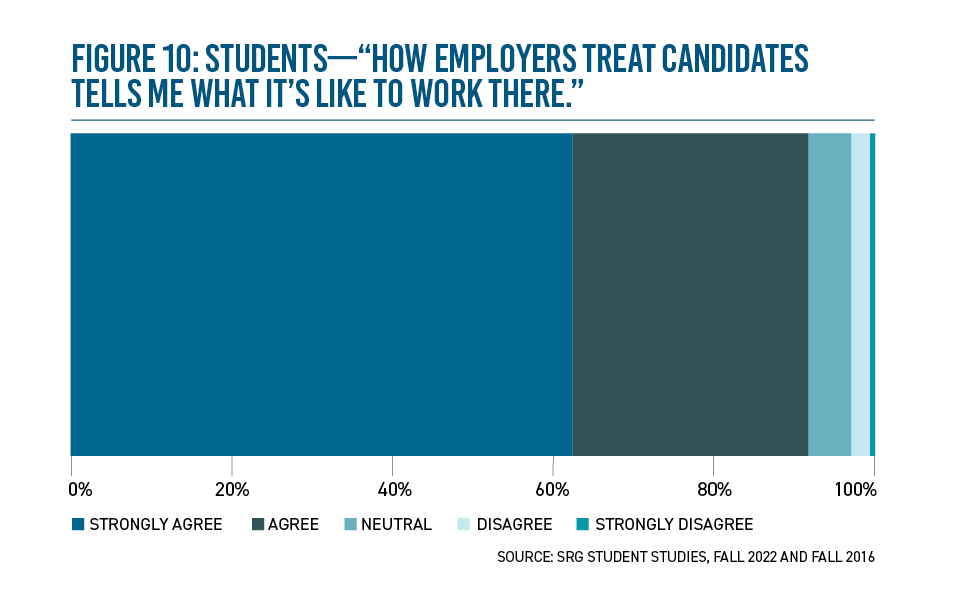
I’ve read articles that report on how much has changed in the early talent recruiting world over the past three years since the pandemic turned our profession on its ear. Certainly, there has been a dramatic transformation in how many employers recruit, most notably in regards to implementing a hybrid recruiting model. What hasn’t changed, however, is what students value in the candidate experience: how they want to be communicated with, what they value in recruiting events (Exhibit A would be the resurgence in campus career fair attendance), and how they differentiate among employers.
The pandemic has indeed changed a lot, but it has not altered what students consider an authentic candidate experience—or why it matters.





